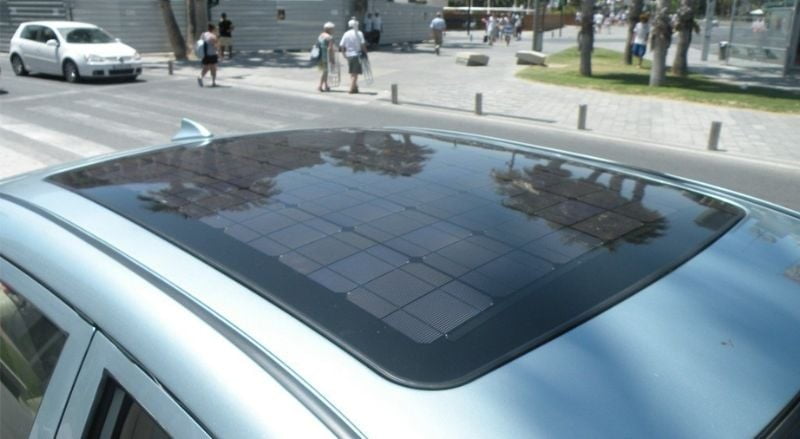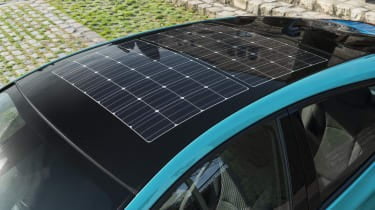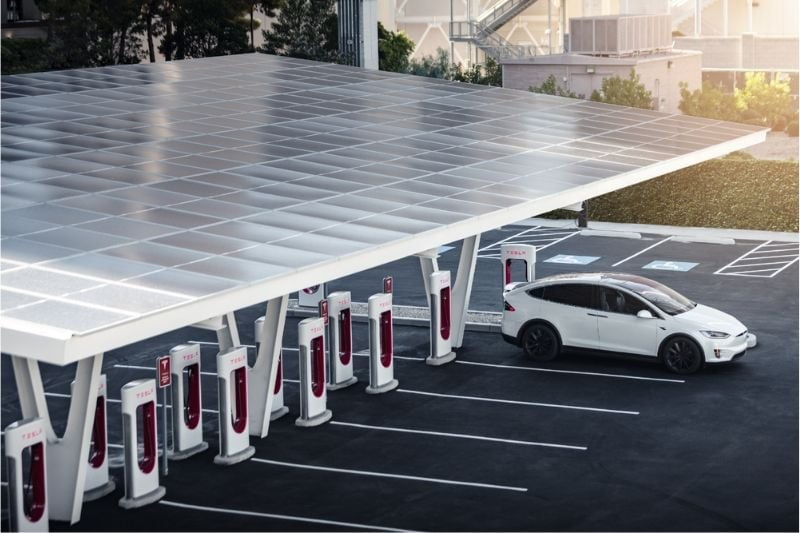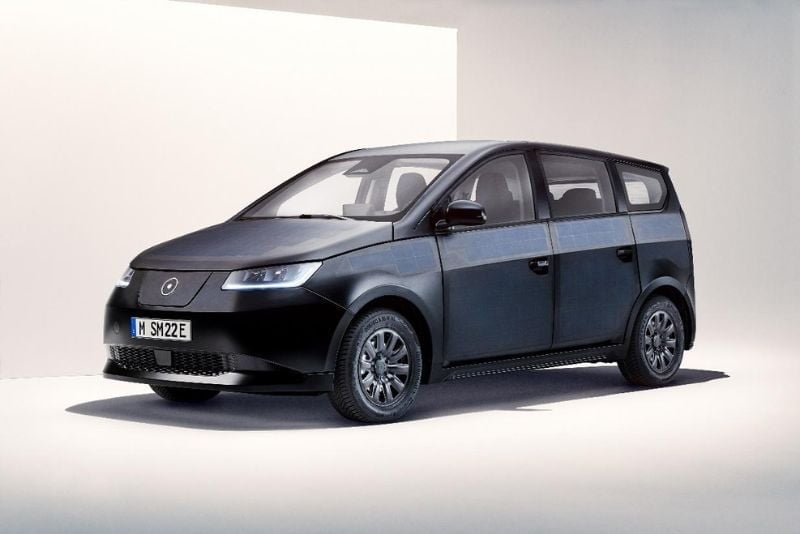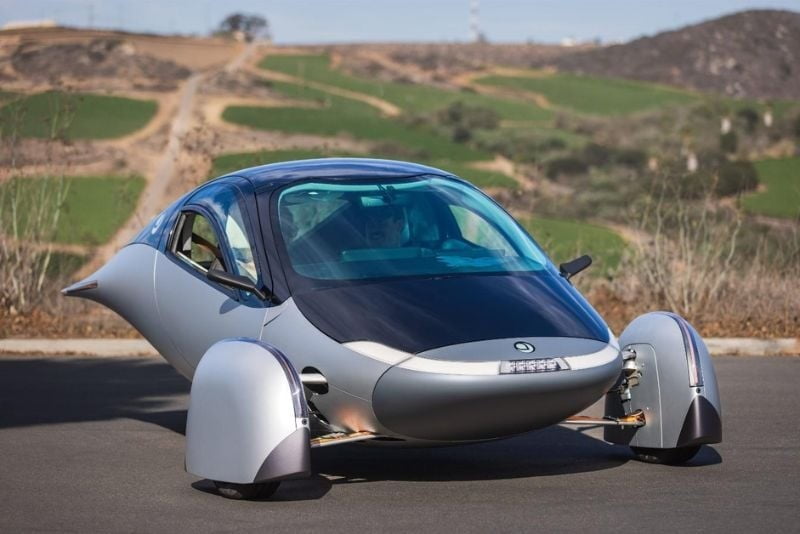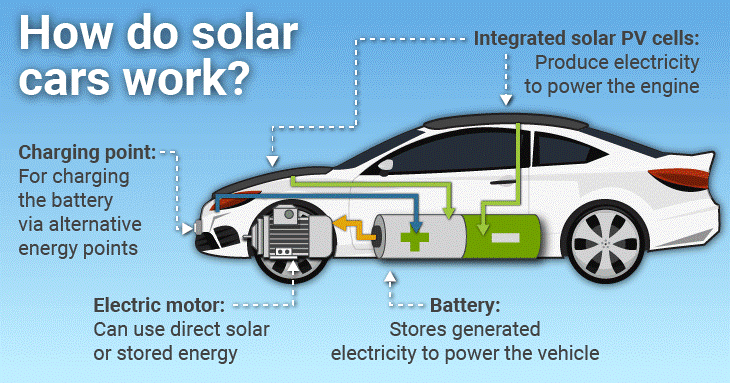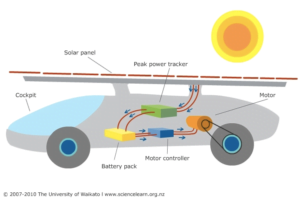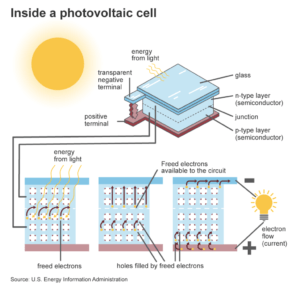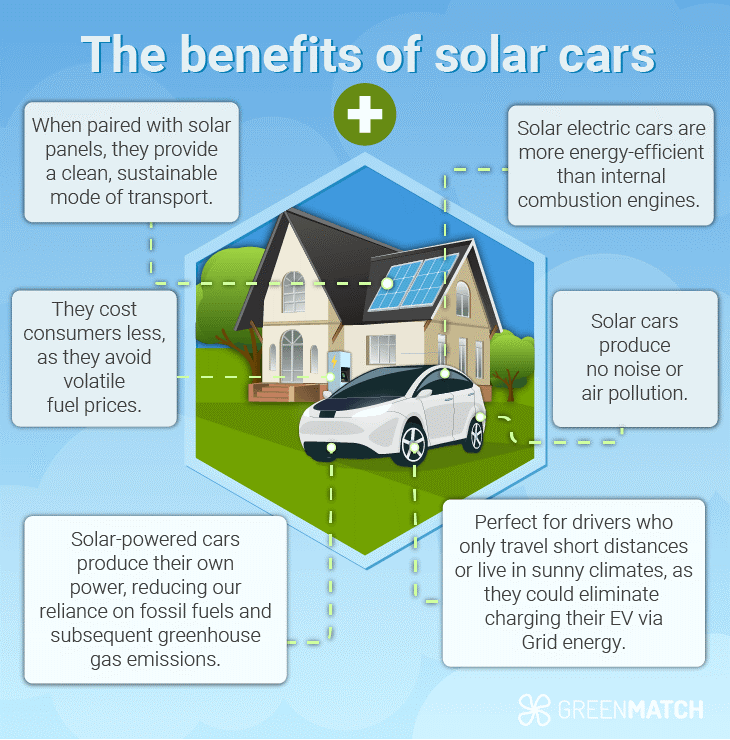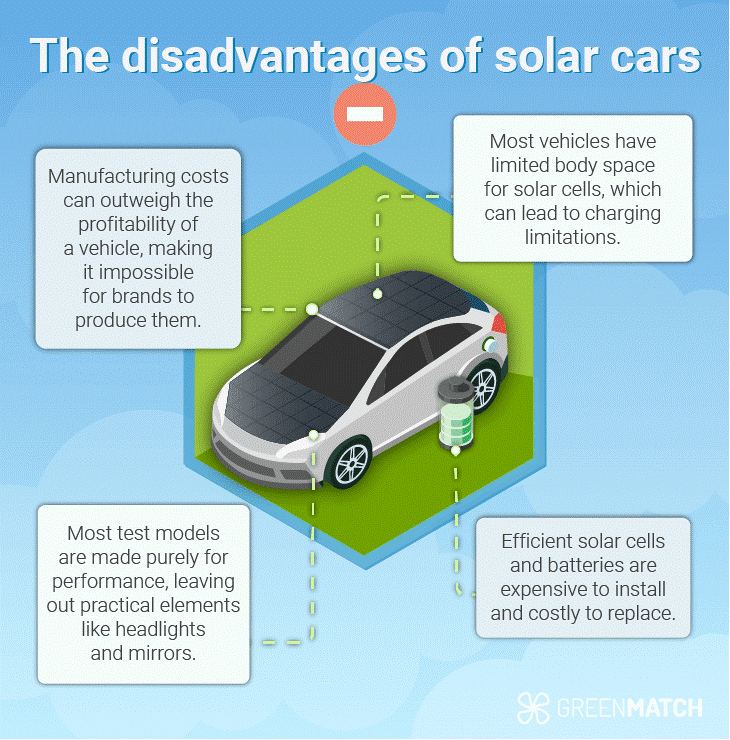Electric vehicles with built-in solar panels seem like a good idea—until you confront reality.
If you leave physics out of the picture, some ideas can be attractive. For example, solar-powered cars seem simple enough—just add a few photovoltaic (PV) panels on top of an electric vehicle (EV), and voila! Infinite range provided by the sun.
How Photovoltaics Function
PV cells, also known as solar cells, convert sunlight directly into electricity. Most commercially available cells are made of semiconductor materials, such as silicon, which have unique electronic properties. When a photon of light hits a PV cell, it can excite an electron and cause it to jump from a lower to a higher energy level, creating an electric current that can power electrical devices.
The efficiency of a PV cell is measured by how much sunlight it converts to electricity. The most efficient PV cells currently have efficiencies of around 25 percent. Still, researchers are working to develop even more efficient cells—the most recent perovskite cells are reaching levels of nearly 30 percent.
Powering Transportation With the Sun
There is already a good chance some of the electricity charging EVs comes from the sun
through solar farms helping to power the grid. In the U.S., about 16 percent of the grid is powered by solar energy (in California, solar electricity generation accounts for 27 percent of the total). By comparison, China’s contribution of solar energy to its power grid is 33 percent.
Solar panels that cover the entire body surface of a car could be able to generate 1-2 kW at peak output:
There lies the potential of solar power in electric vehicles, but there’s some way to go. To fully realise that potential, solar technology needs to evolve so that panels can be integrated over more of the car’s exterior – including within the glass – be impact-resistant, durable and operate efficiently in a range of temperatures. They need to get cheaper too.
About 80 percent of all EV charging in the U.S. is done at home, and a fairly large number of EV owners also have home solar electricity systems. In California, for example, about 30 to 40 percent of people with EVs also have solar panels. Solar energy to charge an EV saves money but requires a fairly robust solar charging system.
On average, U.S. drivers travel 13,500 miles per year or about 40 miles daily. The 2022 Hyundai Ioniq 5’s fuel economy rating is 30 kWh per 100 miles. This means 12 kWh of electricity each day to travel 40 miles. The average number of peak sun hours per day in the U.S. is between five and six hours, with a reasonable estimate of an average of five hours of usable sunlight per day. Generating 12 kWh of energy over 5 hours requires 2.4 kW or 2,400 W of solar electricity production per hour.
Common home solar panels can produce 400 W of electricity and are around 20 square feet. Discounting power losses (about 15 percent) when converting the DC PV solar panel to AC used to charge the EV, it will take a minimum of six solar panels (more like seven panels when losses are accounted for) to power the Hyundai Ioniq 5 on its typical 40-mile daily commute. The solar energy must be stored in a battery system so the EV can be charged from the saved-up solar energy at night.
In addition to solar-powered home charging stations, it is possible to build covered parking lots whose rooftops are covered with solar panels to provide charging energy to a large number of EVs at the same time. In addition, the covered parking can reduce the need for cooling the car’s interior, which is normally necessary after parking for a full day in the sun.
On Vehicle Solar Power
The Hyundai Ioniq 5 is about 15 feet long and about six feet wide, giving it a plane surface area of 90 square feet. A 400-watt solar panel is approximately 20 square feet, so if every inch of the Ioniq 5 could be used as a solar panel, the total electricity generated would be 1,800 Wor about 1.8 kW. During an ideal five-hour day, if the Hyundai were parked just the right way, it could generate about 9 kWh, enough energy to travel about 30 miles. The Ioniq 5, however, has windows and sloped surfaces that point in different directions, so realistically, the range provided by our solar-powered Ioniq 5 is 10-20 miles per day.
Nevertheless, competitions have been held for experimental solar-powered cars traveling long distances, such as across the U.S. or the Australian Outback. Typically, such vehicles are long and wide to provide a maximum amount of surface area for the solar cells and are designed for a single driver and virtually no creature comforts.
A city’s urban canyons caused by tall buildings, along with trees and other obstacles, present additional problems for onboard solar charging of EVs. The results showed that charging within a city reduced the range provided by half to roughly 6-18 miles per day. Not surprisingly, cities nearer the Equator in Africa, the Middle East, parts of southern Europe, and Southeast Asia showed the best possibilities. In contrast, cities in China, North America, and Australia could have greater challenges but still might be acceptable.
There are uses for solar panels directly on vehicles beyond the direct charging of traction batteries. Small solar panels on the roof or trunk surface can be used to operate low-consumption equipment (such as an air-circulating fan) or to help keep a low-voltage battery fully charged. These panels cannot power the vehicle but can be used to keep it more comfortable and ready to go.
Dreaming the Solar Car Dream
Even if onboard solar power for the primary charging of an EV seems a non-starter, at least three companies have been working on bringing such vehicles to market.
Long-range solar electric vehicle.
Designed by former Ferrari and Tesla engineers, the car is purported to add 7.5 miles per hour from its solar charging, with 45 miles of driving range added on a sunny day. Given that the 90 square feet of surface area of an Ioniq 5 would provide less than 30 miles of range after a day of charging its hypothetical solar panels, the estimates from Lightyear seem far beyond optimistic.
A $250,000 version of the Lightyear briefly went into production at the end of 2022. However, in January 2023, Lightyear’s parent company, Atlas Technologies, was declared insolvent by Dutch Courts. A month later, Lightyear announced that it had reorganized and secured enough funding to begin work on a much more affordable Lightyear 2 model that could be launched in 2025 with a U.S. price tag of $40,000.
Sono Sion
Instead of building a $170,000 luxury sedan, Sono Motors was looking at building a $30,000 small crossover utility hatchback vehicle primarily powered by the sun. Sono Motors had previous solar experience, developing power systems to operate the cooling systems of refrigerator trucks. Sono claimed that the onboard battery would provide 190 miles of range, while the solar panels covering nearly every surface would add 70 to 150 miles per week. This breaks down to between 10 and 50 miles per day, which is reasonable, at least at the lower end.
Sono Sion, a solar electric car. Image used courtesy of Sono Motors
Aptera
Instead of building luxury sedans or mainstream SUVs, U.S.-based Aptera decided that the world needed a tiny, two-passenger, three-wheel flyweight commuter vehicle. Since the car is small, light, and highly efficient aerodynamically, it takes much less energy to move it down the road. Fifteen years ago, when Aptera started, the idea was to use a small gasoline engine. Eventually, that concept transitioned to power by lithium-ion batteries and an electric motor. Now, in its latest iteration, Aptera has decided solar electric power is the way to the future.
Aptera solar-electric vehicle. Image used courtesy of Aptera Motors Corp.
Aptera has had a strange trajectory. The company was originally founded in 2006 and, aided by a $184 million U.S. government loan for advanced vehicles, participated with its gasoline-powered three-wheel vehicle in the 2010 automotive X-Prize. Unable to find sufficient funding to remain afloat, the company was liquidated in 2011.
What are solar electric cars?
Unlike standard electric vehicles, which need to be charged through a plug-in electric/EV charger, solar cars have unique panels built into the car’s body. These panels work similarly to home solar panels, absorbing sunlight and converting it into energy.
In theory, this system would allow a car to generate its own electricity and avoid any need for external charging or harmful fossil fuels to power it. With transport in the UK responsible for nearly a quarter of the country’s carbon emissions, having a vehicle that could run on clean, renewable energy is an incredible prospect.
These vehicles, however, still need to be widely produced, and although some manufacturers have produced models, there are still a number of drawbacks to overcome. The biggest issue is that solar electric cars are very expensive to produce and, therefore, expensive for the average consumer to invest in. This expense comes from the complexities of creating specialised solar panels to fit into the body of a vehicle.
How do solar-powered cars work?
As we can see in the above diagram, solar electric cars work by incorporating highly advanced, specialised solar panels into the car’s design. Often referred to as vehicle-integrated PV (photovoltaics)or VIPV, they use the same science which determines how home solar panels work.
For vehicles however, individual cells (or modules), are built-in or installed on rooftops, bonnets or side panels to ensure wide surface area coverage, allowing for the most sunlight to reach the cells. The use of smaller PV cells, rather than large panels, also means they are lighter, which is better for the vehicle’s overall performance.
Design and Components of Solar Vehicles
The solar cells can produce electricity to directly power the engine, or be stored in a solar battery pack that’s integrated into the vehicle’s body. Given the right design, this clever system means solar power can be used in multiple vehicle types, including public transport such as buses, planes or trains.
Despite the complex nature of this technology, and the detail needed to incorporate it into our vehicles, more car manufacturers are starting to trial and test a solar-powered method.
Step-by-step: How do solar electric cars work
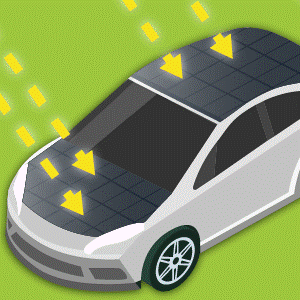
1. Solar cells:
Solar cars are equipped with photovoltaic solar panels (or cells), which convert sunlight into electricity.
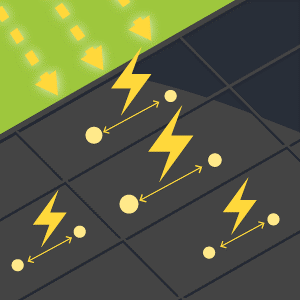
2. Electricity generation:
When sunlight (photons) strikes the photovoltaic cells, it excites electrons and allows them to flow, creating an electric current.
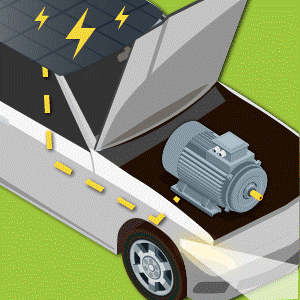
3. Powering the motor:
The electricity generated from the solar panels is used to power the vehicle’s electric motor.
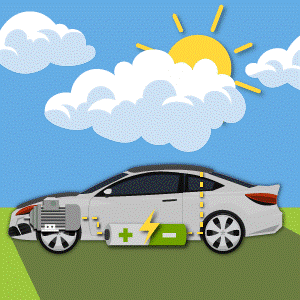
4. Battery storage:
Solar vehicles typically contain a rechargeable battery to store excess energy from the solar panels, which can be used when sunlight is unavailable or insufficient.

5. Regenerative braking:
Some solar vehicles use regenerative braking, where the electric motor switches to generator mode, converting the moving vehicle’s kinetic (motion) energy back into electricity to recharge the battery.
Comparison between solar electric cars and traditional electric vehicles
Solar and traditional electric vehicles differ in power source and charging methods. Solar vehicles can use sunlight for power, which is generated through solar panels built into the body of the vehicle. However, traditional electric vehicles must be plugged into a charging station and fed electricity from the grid or a renewable energy source.
There are some other key differences between the two vehicle types, as outlined in the table below.
Solar Electric Vehicles | Traditional Electric Vehicles |
Use a renewable energy source and reduce reliance on grid electricity | Electric vehicles can be charged from the grid, offering more flexibility in charging |
Have the potential for unlimited range, as long as there is consistent sunlight for charging | Electric cars are not limited by climate or driving conditions and can be charged using renewable energy sources such as solar and wind power |
Solar charging can be cheaper than grid electricity, leading to lower operating costs over the long term | Standard EVs are more technologically mature and widely available, with an established charging infrastructure |
They have zero emissions and don’t emit any pollutants | Recover and store energy during braking, further enhancing their efficiency |
While both types of vehicles offer substantial reductions in carbon emissions compared to conventional vehicles, they differ significantly in their design, operation, and environmental impact.
The efficiency of both vehicles is influenced by factors such as energy lifecycle emissions, infrastructure requirements, and overall environmental footprint. The choice between the two depends on driving conditions and the availability of sunlight for charging on the go.
Can you buy a solar-powered car?
A solar-powered car still needs to be something you can find at a local dealership. This is because the costs behind the production of these vehicles are still very high, and only a few big-name manufacturers are putting solar designs into mass production.
You can, however, get your hands on a solar electric car if you’re willing to stay on a waiting list or put down an upfront reserve payment. Only a few companies are developing solar-powered cars or putting them out for production.
Benefits of solar cars
Sustainable transportation
The greatest benefit of solar electric cars is their sustainability. By generating their own power, they reduce the need for us to use fossil fuels as an energy source. This eliminates all of the harmful emissions we expect from standard road vehicles.
Zero emissions
Transport emissions include CO2, nitrogen oxides, particulate matter and ammonia, all of which are high-level pollutants. Not only do they impact our climate, but they are particularly harmful to human health and air quality.
Efforts to reduce these emissions are crucial for mitigating their impact, this is why solar-powered vehicles are beneficial. They don’t use a combustion process to power the engine, therefore these pollutants do not exist. Solar electric cars have zero emissions, making them healthier and more environmentally friendly than any other road vehicle option.
Cost savings
Solar-powered cars can result in significant cost savings for several reasons. Firstly, they eliminate the need for pricey fuels, which can lead to annual savings of nearly £3,000. In addition, solar vehicles don’t require the same internal moving parts as petrol or diesel cars, which in theory can result in less ongoing maintenance costs.
Advances in technology
As more work is done to trial and test solar power in vehicles, it presents further opportunities for technology to advance and become more efficient and accessible. Several car manufacturers are already integrating solar technology into their vehicles due to the advances in PV cells.
If solar cell efficiency and design improves, it could lead to more vehicles adopting the technology, further reducing our reliance on fossil fuels and improving our transport’s environmental impact.
Disadvantages of solar-powered cars
Reinventing the way we power our transport is no easy task, and although solar seems like the ideal solution to our emissions problems, it’s not without its drawbacks. Incorporating solar cells into vehicles does have disadvantages and there are some key reasons we don’t already have solar electric cars on our doorstep.
Limited range
Solar-powered vehicles often have a limited drive range due to the space available for solar panels on the vehicle. The range of a solar-powered car with a full charge can vary based on the specific model and the amount of sunlight available.
The driving range can stretch from 40 to 440 miles of solar-powered drive per day depending on the model. Most will have additional range capabilities when combined with a plugin charge. The actual range, however, can be influenced by factors such as weather conditions, driving habits, and the efficiency of the solar panels.
Solar panel efficiency
As technology stands currently, solar panels are not efficient enough to power vehicles to the same extent as standard fuels. For example, a state-of-the-art solar panel can only reach an efficiency of 60%, which means users can never obtain 100% efficiency.
With this fact in mind, it’s no surprise that car manufacturers aren’t lining up to produce solar-powered cars when the current technology is not advanced enough yet to make a car which can generate adequate power to run itself.
High costs
Designing and producing a solar vehicle is an incredibly expensive process. Incorporating solar cells into a car build is very complex, and developing high-performance panels can be costly.
In fact the cost to produce a solar vehicle can be so high, that one company has already gone bankrupt trying to bring these cars to market. Demand is also not as high as you would expect – the range limitations and lack of choice mean there are not as many consumers willing to pay the cost.
Charging other electric vehicles with solar?
Despite the drawbacks of a solar vehicle, we still have the option to power our EVs with solar in different ways. Solar power gained from panels on our homes can offer us an alternative way to make use of a sustainable, low-carbon power source for our transport.
It is possible to use solar energy you generate at home to charge your vehicle, particularly if you have solar batteries which allow you to store excess energy. This can offer you a free way to power your EV charger and therefore fill your car with clean solar energy.
If solar compatible, some charging equipment can be connected to your home’s solar system inverter (this is where electricity from your panels is converted into a safe current for use in the home). This can give you direct access to solar energy for your charging point.
Solar-powered EV charging is a sustainable and environmentally friendly way to fuel your electric vehicle. It significantly reduces greenhouse gas emissions associated with conventional fuels or even grid-powered EV charging.
Installing solar panels for electric vehicles
For a typical family home, installing solar panels can cost anywhere from £6,000 to £11,000. However, the potential savings are estimated at over £400 per year. When you consider combining your solar energy with fueling your electric vehicle, further savings can still be made as you replace fossil fuel expenses.
Using this method is an all-around cleaner, more environmentally conscious way of powering your vehicle. It’s convenient, as you can charge your car at home and overnight (if you have a solar battery), so you’re ready to go in the morning.
Although installing solar panels is an upfront investment, you will be making huge savings overall. Both at home, with reduced energy bills and for your car’s fuel costs, as you can effectively charge your vehicle for free.
Future of solar electric cars
Despite its many positive benefits and potentials, it’s still very early days for the solar-powered vehicle. We’re yet to see a manufacturer create a car that has it all, with the perks of free, zero emissions power but a great driving range, for a reasonable price.
Solar electric cars are the most efficient and sustainable mode of transportation we could hope for. In a world ever more crammed with harmful emissions and dangerous pollutants, seeking clean and sustainable ways to travel is vitally important.
The advances that companies such as Lightyear and Aptera are making in the electric vehicle industry are incredible. With minds like those behind the Stella Terra, we could see the dawn of even more advanced solar technology within a few years.
The solar-powered automobile industry is also expected to experience growth in the global market. Projections suggest that by 2031, the market size could reach a value of GBP 34.58 billion with a compound growth rate (CAGR) of 35.50% from 2022 to 2031.
With hopes of further capabilities in the future, lower production costs and more accessibility, we may just see the glimmer of a fully functional, everyday car powered entirely by the sun rolling onto our streets.
But, while we wait for these innovations to become reality, the sun is still shining down, ready to help us power electric vehicles today. Charging our transport with solar is the greenest and most sustainable way to clean up our transport – until our solar cars are ready!
